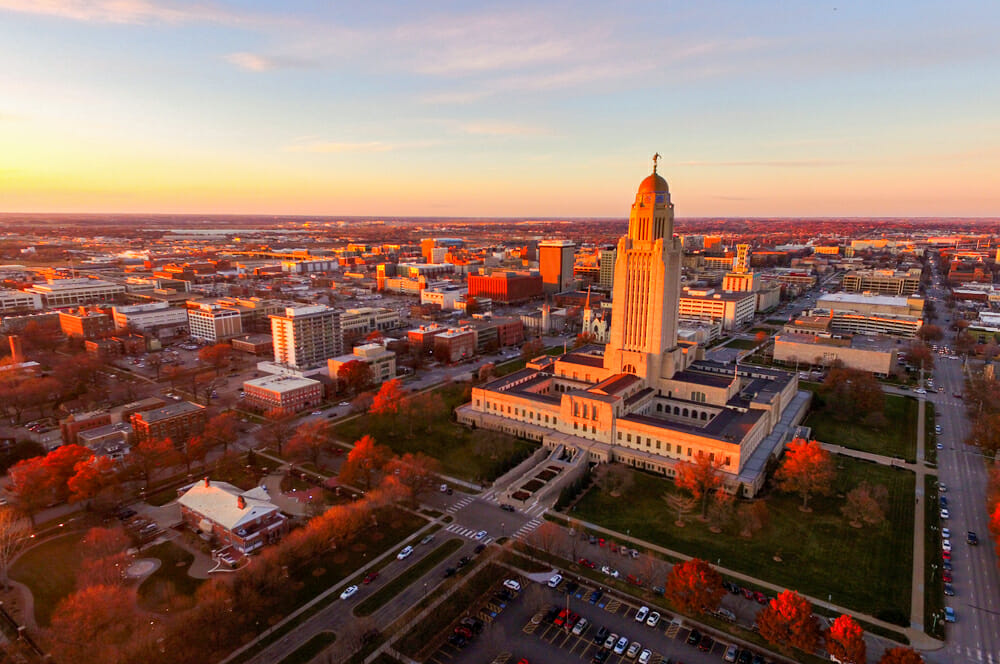
Criminal Rehabilitation and Justice in Nebraska
The following sections provide a brief outline of crime, incarceration, rehabilitation, and alternatives to prison in Nebraska.
Prison Population Statistics in Nebraska
How many people are incarcerated in Nebraska? What are the biggest prisons in Nebraska? Does Nebraska have private prisons? Answering these questions will quickly give one an understanding of Nebraska’s criminal justice and incarceration model. According to the Bureau of Justice Assistance, Nebraska has the 31st highest incarceration rate in the U.S., ahead of Iowa but behind North Carolina. Nebraska incarcerates about 269 people for every 100,000 living in the state.1
According to information published by the National Institute of Corrections, Nebraska has 63 jails operating in 93 counties. The state’s jail population was 4,240 as of 2019. Nebraska also operates ten state prisons, where it incarcerates 5,682 prisoners. The state’s Community Corrections program has 13,023 offenders under probation and 959 under parole. Nebraska operates its Department of Corrections with 2,300 employees and an annual budget of $215,420,240.2
There are no private prisons in Nebraska, nor are there any federal prisons in the state. Of the state’s prisons, the Nebraska State Penitentiary is the largest of the state’s facilities, with 1,288 inmates. Unfortunately, Nebraska does struggle with a growing overpopulation problem within its prisons. For example, Nebraska’s largest prison is at 157% design capacity and 126% operational capacity.3
Nebraska Crime Rates

The Nebraska Crime Commission provides annual reports disclosing the types of crime recorded yearly, highlighting whether those crime rates have risen or fallen. According to the data, Nebraska records about 6,473 violent crimes each year, a rate of 330 violent crimes per 100,000 people living there. That figure is just below the national median for violent crime. Each year, Nebraska reports about 70 murders, 1,100 rapes, 800 robberies, and 4,400 aggravated assaults.4
Recidivism Rates in Nebraska
Statistical data on recidivism is crucial to understanding a state’s criminal justice system. While Nebraska has one of the lowest recidivism rates in the Midwest, it is still quite high, at about 29%. That means the criminal justice system is not working for almost one-third of the offenders who go through it, as they are reoffending and becoming re-incarcerated within three years of release.5
Criminal Reform in Nebraska
Criminal rehabilitation in Nebraska must be carefully studied because rehabilitation is how offenders are helped to overcome criminal inclinations and illegal behavior. Programs used in Nebraska prisons should not seek to punish or dehumanize offenders, but should rather rehabilitate them. Criminal reform in Nebraska begins with helping offenders overcome the criminal inclinations that landed them in prison.
According to the Nebraska Department of Correctional Services, removing offenders from the community and placing them in jail is only one part of the department’s mission to “Keep people safe.” Quoting the department, “Rehabilitation is a key component to keep people safe. It includes clinical treatment, non-clinical (cognitive/behavioral) programming, education, vocational and life skills training and engagement in pro-social activities. Planning ahead for release is necessary for successful reentry into the community and includes social work services for high needs individuals and intentional reentry planning for all individuals.” While these programs sound good on paper, the high recidivism rate in Nebraska discussed earlier suggests that state policymakers could improve criminal rehabilitation programs in Nebraska.6
Alternatives to Incarceration in Nebraska

Criminal justice policymakers should also expand alternatives to prison in Nebraska because they give offenders a way to experience reform without being exposed to the harmful nature of the carceral system. Particularly for nonviolent offenders and drug possession crimes, incarceration alternatives in Nebraska can provide offenders with the tools they need to have a happy, productive, and meaningful life without committing a crime.
Unfortunately, the criminal justice system in Nebraska is extremely limited in the types of incarceration alternatives it offers. Some reports suggest Nebraska prisons are at 150% capacity, yet the state has been unable to produce incarceration alternatives to reduce the burden on state prisons.
Thankfully, the state has begun improving its vocational training programs for offenders. Former Senator Brad Ashford, who’d been involved in the program, spoke to its relevance. “We’re not simply going to send an offender out on the street looking for work. We’re going to have hopefully a laundry list of potential employers within the state who would be willing to hire ex-offenders, that sort of thing,” he said. “If someone is working, if someone is reuniting with their families, if someone has adequate housing, they’re much less likely to go out and commit another crime.” If implemented, this program will be a means for reducing offender sentences and helping offenders find gainful employment, housing, and social support.7
Looking to the future, state policymakers and justice experts should improve educational programs inside prisons in Nebraska and rehabilitation programs inside prisons in Nebraska. Further, policymakers and criminal justice leaders should expand incarceration alternatives. If offenders in Nebraska are provided with real solutions that include education, rehabilitation, life skills, better decision-making resources, coping strategies, vocational training, and job opportunities, the overall quality of life in Nebraska will improve, public safety will go up, and families will be reunited.
Sources Cited:
- BJS. “Prisoners in 2020 – Statistical Tables.” Bureau of Justice Statistics, 2020. bjs.ojp.gov
- NIC. “Nebraska 2019.” National Institute of Corrections, 2019. nicic.gov
- JournalStar. “Nebraska’s 10 state prisons from least to most crowded.” Journal Star, 2022. journalstar.com
- NCC. “Nebraska Crime Commission: Arrest and Offense Data.” Nebraska Crime Commission, 2022. ncc.nebraska.gov
- SCN. “Recidivism Rates for Nebraska Juvenile Probationers: 2010 to 2015.” Supreme Court Nebraska, 2018. supremecourt.nebraska.gov
- NDCS. “Rehabilitation.” Nebraska Department of Correctional Services, 2022. corrections.nebraska.gov
- NPM. “Prison alternatives being considered in Nebraska.” Nebraska Public Media, 2014. nebraskapublicmedia.org
Related Articles
Students Succeeding in US Correctional Facilities
"What a wonderful way of life. Drugs can and will destroy any chance of success or happiness to anybody's life. I always thought them to...
Read more >>


